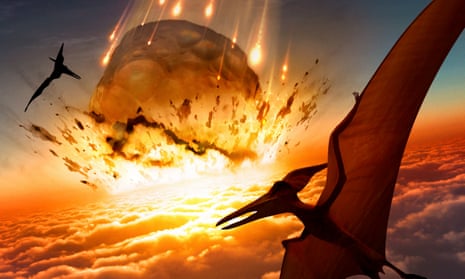The massive asteroid that slammed into Earth and wiped out the dinosaurs might never have triggered a mass extinction had it struck almost any other part of the planet, scientists claim.
In work that reveals just how unlucky the prehistoric beasts were, researchers calculate that the odds of the enormous space rock wreaking such havoc were low across 87% of the Earth’s surface.
Unfortunately for the dinosaurs, the 9km-wide asteroid thumped into the ground in what is now Mexico’s Yucatan peninsula, where the concentration of hydrocarbons in the rocks was so high that the soot and sulphate aerosols sent into the sky caused global cooling and drought. The impact crater near the town of Chicxulub is 180km wide and 20km deep.
Writing in the journal Scientific Reports, Kunio Kaiho and Naga Oshima at Tohoku University in Japan describe calculations that suggest only 13% of the Earth’s surface harboured rich enough hydrocarbon deposits to cause a mass extinction in the event of such a devastating impact.
The work builds on a growing body of research which suggests that finding themselves a collision course with an enormous asteroid was only the start of the dinosaurs’ problems. In 2014, an international team of scientists argued that the beasts might have survived had the rock struck at a “more convenient time” when species were more diverse and so more resilient.
The latest research suggests that, for the dinosaurs at least, the rock might have crashed into a more convenient region, too. Asked to sum up the dinosaurs’ fate, Kaiho, a professor of paleontology, said: “They were unlucky.” On the plus side for us, the demise of the dinosaurs allowed mammals to flourish.
The catastrophic event 66m years ago unleashed tsunamis and earthquakes around the world. Material blasted into the stratosphere obscured the sun and chilled the Earth by as much as 10C. The planet’s ecosystem swiftly collapsed, with land plants withering and the dinosaurs, already in long-term decline, meeting an abrupt end. In all, the devastation wrought by the impact drove 75% of all land and sea animals to extinction.
Kaiho told the Guardian that if the asteroid had hit the Earth where the rocks harboured less organic material “no cooling, or small cooling, would have occurred.”
In the study, Kaiho and Oshima worked out how much soot and sulphate would be blasted into the stratosphere by a virtual asteroid impact, depending on the amount of hydrocarbons and sulphate in the ground. They found that the asteroid would have to throw between 230m and 2,300m tonnes of soot into the upper atmosphere to cool the planet enough to trigger a mass extinction. But only 13% of the Earth’s surface contained sufficient hydrocarbons to do this.
Writing in the journal, the scientists argue that stratospheric soot may have been the main driver for the death of the dinosaurs. “The site of asteroid impact, therefore, changed the history of life on Earth,” they add.

Comments (…)
Sign in or create your Guardian account to join the discussion